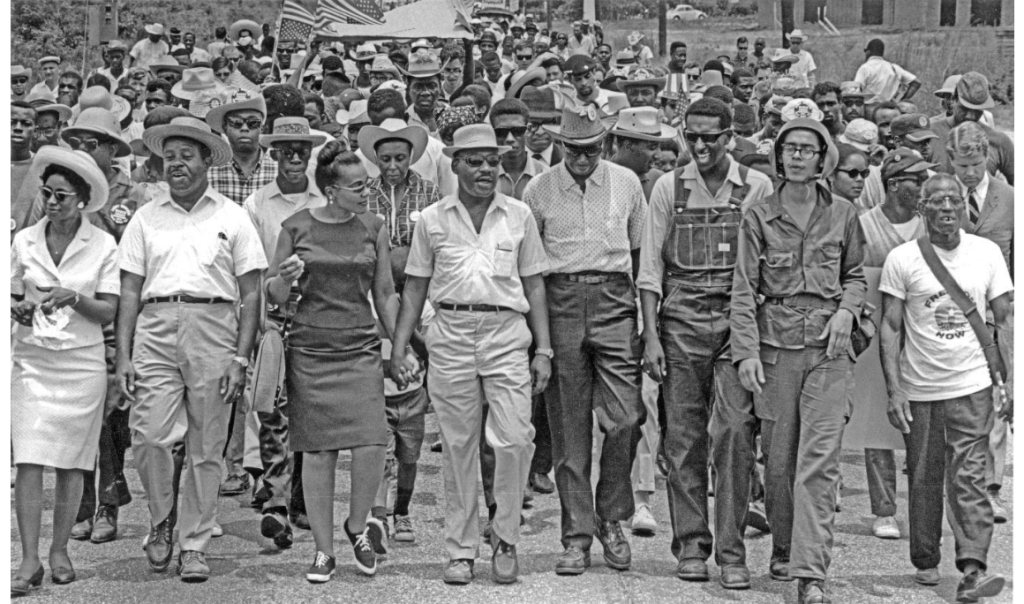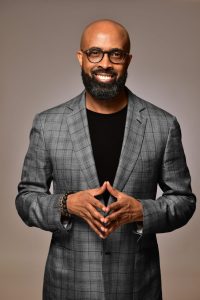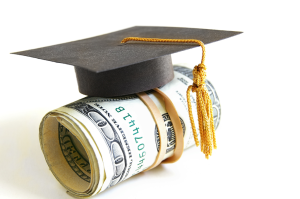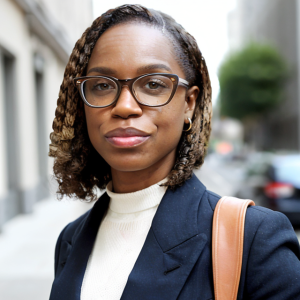“Dr. King was my hero and he understood my mission as well as he understood his own,” James Meredith said from the bowels of the noisy coffee shop in South Jackson just minutes before the MLK Day Parade 2023 was scheduled to begin.
King had had his Selma to Montgomery March that looked like a major disaster from the beginning but ended up with the passage of the Voting Rights Act of 1965, Meredith said.
“I was at war against the State of Mississippi and Dr. King was one of only a few people who knew what I was expressing.”
Meredith began his Walk Against Fear on June 5, 1966, looking a lot like the only person on earth with any idea of why he was trekking along Highway 51 from Memphis to Jackson. The march ended in Jackson on June 26 with over 15,000 supporters from all over the country at the final rally.
“Martin Luther King was the only person who fully understood everything that James Meredith was about. That’s why he wrote his letter from the Birmingham jail. And that was three years before he ever met me.”
In his letter of 1963 from the Birmingham jail, King had said that Meredith, the first African American to integrate the University of Mississippi in 1962, “is a hero of the Civil Rights Movement.”
DEATH’S DOOR
In Harlem to sell and sign copies of his new book Stride Towards Freedom on September 20, 1958, King was approached by Izola Curry, later diagnosed as a paranoid schizophrenic, who asked King to identify himself. When he did so, she plunged a steel bookmark into his heart and he slumped to the floor as the metal instrument remained in his chest. Luckily, the paramedics arrived quickly and rushed King to the hospital.
“The razor tip of the instrument had been touching my aorta and my whole chest had to be opened to extract it,” King later wrote. Curry was confined in New York’s Matteawann State Hospital for the Criminally Insane and spent the rest of her life in a home care program.
King’s doctor told him, “If you had sneezed during all those hours of waiting, your aorta would have been punctured and you would have drowned in your own blood.”
Curry was also carrying a pistol inside her dress, the police disclosed.
Meredith understands the state of King’s mind completely while he was lying in the hospital after being so close to death.
On the second day of his walk towards Jackson, Meredith had been shot by unemployed salesman Aubrey Norvell on the outskirts of Hernando, MS. Norvell had told people marching along the route with Meredith to stand back because he only wanted to shoot Meredith. He fired three blasts of his shotgun. But because it was loaded with birdshot, Meredith escaped death, although he had no idea at the time of how seriously he had been wounded.
“When I got hit, the first thing that came to my mind was that I should’ve had my gun, so I could have put him away,” he said. “I never blacked out. That was the only thing I thought about: I ain’t dead yet.
“Two of the shots hit me, one in the head and shoulders and another in the back.”
“Norvell was the first white man ever convicted in Mississippi for shooting or killing a Black man, woman or child. He was sentenced to 5 years, with three suspended. Even with that, he got less time than he might have if he had shot a dog or a rare species of bird.
“I was the luckiest person in the world because if he had been using buckshot, I would have been killed.”
Meredith was released from the hospital in time to resume the position of leader of his own walk, although now it was renamed The March Against Fear.
AFTER THE SHOOTING
After word of the attack on Meredith was broadcast, an illustrious roster of the outstanding civil rights activists flocked to Mississippi in his support.
King, who was the consensus leader, was joined by Fannie Lou Hamer, Stokely Carmichael, Harry Belafonte, and Floyd McKissick, with the Deacons of Defense providing armed security.
NAACP Field Secretary Roy Wilkins was scheduled to participate in the ongoing march and rally in Jackson but withdrew when he learned the Deacons for Defense would be in charge of security.
Meredith said it was understood before he rejoined the group that he also no longer identified with it.
“I was not a part of the James Meredith March Against Fear,” Meredith says. “That was understood before they started, because I don’t protest anybody. And a march is a protest.”
Meredith said the pictures that he was persuaded to appear in for the media were staged by Andrew Young, King’s top lieutenant at the time.
“In order to make this picture, Andy Young came to visit me, and I agreed to it because King wanted a picture of me and him leading the march. But I didn’t participate in the march. And I insisted that the only way I would make the picture would be if there weren’t any women or children involved. And you don’t see any other women or children besides Coretta and Juanita Abernethy in the shots.
“I insisted that there should be no women or children and the security guy from the Deacons of Defense had to be behind us with his pistol so everybody in America knew he had a loaded gun.”
Although the Student Nonviolent Coordinating Committee (SNCC) was a component of King’s SCLC, the young people of SNCC were on the verge of disavowing any confidence in nonviolence as the way to continue to fight the civil rights cause. It was during the Walk Against Fear, a.k.a. the March Against Fear, that the stage was set for the initiation of the cry for Black Power, and it was almost immediately taken up by young Black freedom fighters not only in the USA but around the world.
On June 16, 1966, marchers began to set up camp on the grounds of the Stone Street Elementary School in Greenwood, Mississippi. There was some confusion as to whether or not they had permission to set up tents on the public school’s grounds. Local white officials confronted the marchers and told them they were not allowed on the school’s property. Carmichael, Robert Smith, and Bruce Bains continued to pitch tents and threaten to have marchers “turn this town out” if arrested. The three men were arrested and charged with trespassing.
Carmichael was released from jail after several hours on June 16 and went immediately to address the 1,500 marchers at a nearby rally. Fellow SNCC member Willie Ricks, who had been prepping marchers all day, encouraged Carmichael to use the slogan “Black Power.” Ricks and Carmichael had become familiar with the phrase and defined it as a call for Black political and economic power. On that night of June 16, 1966, Carmichael proclaimed the era of Black Power.
“We been saying freedom for six years and we ain’t got nothin’,” Carmichael said. “What we got to start saying now is ‘Black Power!’ We want Black Power.”
GATHERING AT TOUGALOO
King had been named the de facto leader of the march in Meredith’s absence. Knowing that the thousands of Black teens and adolescents who had joined the march after Meredith was shot were not sworn to maintain the principles of nonviolence, King assumed a more subtle role and shared the spotlight with the youth and their leaders.
United Auto Workers President Walter Reuther brought 10 buses of union supporters in from Chicago.
As they reached Jackson, the marchers stopped at Tougaloo College and were entertained by James Brown, Dick Gregory, Sammy Davis Jr., Burt Lancaster, and Marlon Brando.
Meredith rejoined them on June 25, the day before the marchers entered Jackson. By that point, they had grown to more than 15,000 participants, making this the largest civil rights protest in Mississippi history. Having registered more than 4,000 new voters along the way, the marchers arrived at the state capitol on June 26.
RE-EXAMINING THE DREAM
The following year, and the year before his assassination, King reflected on his beliefs and how they had been affected by the rapidly changing events around him. King revealed his thoughts to NBC’s Sander Vanocur on May 8, 1967.
“I must confess that the dream that I had has in many points turned into a nightmare,” he said. “Now I’m not one to lose hope. I keep on hoping. I still have faith in the future. But I’ve had to analyze many things over the last few years and I would say over the last few months.
“I’ve gone through a lot of soul-searching and agonizing moments. And I’ve come to see that we have many more difficulties ahead and some of the old optimism was a little superficial and now it must be tempered with a solid realism.”
King was assassinated by James Earl Ray in Memphis on April 4, 1968.
Meredith, steadfast in his convictions, says he will continue with the missions that he mapped out with his father, Moses Arthur “Cap” Meredith, while on the threshold of manhood. First was the integration of Ole Miss. Second was the Walk Against Fear.
“He called every major shot,” Meredith said of his father. “He engineered the Ole Miss thing and the March Against Fear exclusively. And everybody talks about Mississippi’s Black people having done nothing before the Movement. That’s crap beyond the reality that I and a whole lot of other people know.”
His third mission, he says, “is to raise the moral character level of Christians all around the world.”
“It’s in our hands,” he insists. “Our future and the future of all Mississippi and America is in our hands. We’re the only people positioned now to do God’s will.
“If we uplift our moral character, rebuild our families and rebuild our schools, our education system, and our justice system, then the rest of the Christian world will follow.”






